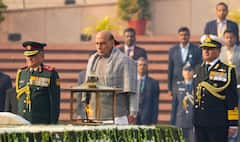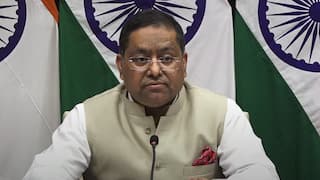Explorer
Advertisement
How to check FB or call while flying: In-flight internet technology explained

Air India. Photo: AFP (Representational)
Fasten your seat-belts - and log on. You may soon be able to call people up, send office emails, check Facebook as well as watch instant videos while air-borne, according to a proposal approved by the Telecom Commission allowing air travellers in India to access in-flight mobile and internet services.
Passengers, used to being told by the crew to switch of all electronic devices, have been wondering how the system would work. PTI answers some frequently asked questions.
What is in-flight internet technology?
In-flight connectivity systems primarily use two kinds of technology. In the first, an onboard antenna picks up signals from the nearest tower on the ground. The connection will remain seamless up to a certain altitude unless the plane passes over an area without ground towers.
In the second scenario, satellites beam signals directly to antennas installed on the airline. This is more effective when the airline is passing over a water body compared with ATG (air-to-ground)-based networks which use satellites to beam the signal first to a transmitter on the ground and then to the antennas on the airline.
What happens next?
The data is transmitted to a personal electronic device such as a smartphone or a laptop through an onboard router, which is connected to the plane's antenna.
The antenna transmits the signals, through satellites, to a ground station, which redirects the traffic to a billing server that calculates the data consumption.
In case the internet services through onboard WiFi are permitted to be used only in flight/airplane mode, the plane's antenna will link to terrestrial Internet services provided by telecom service providers.
When the aircraft has climbed to 3,000 metres, normally five minutes after take-off, the antenna will switch to satellite-based services. This will ensure continuity in the Internet services to passengers and prevent cross-interference between terrestrial and satellite networks.
The airlines may depend on the services of either foreign satellites or ISRO's indigenous GPS-aided geo-augmented navigation system (GAGAN) for the purpose.
GAGAN was jointly developed by ISRO and the Airports Authority of India (AAI) with a view to assisting aircraft in accurate landing. The GAGAN signal is being broadcast through two Geostationary Earth Orbit (GEO) satellites - GSAT8 and GSAT10.
What are the challenges?
For the technology to function, airlines and service providers will have to put a server on the flight along with the equipment to convert satellite signals into data packets. They will also have to add the equipment to re-orient the antenna to face the satellite so the reception quality is not affected.
Interruptions, when the airline moves from the range of one satellite to another, are bound to happen. In general, in-flight WiFi is expected to be slower than on the ground. However, latest technologies may change that scenario.
Will users have to pay more?
Airline passengers may have to bear the initial cost of installing antennae on aircraft. It would be easier for airlines to have the equipment installed on the new aircraft rather than taking planes out of service for retrofitting.
The additional costs could find a way into ticket fares, unless the airlines, despite rising jet fuel prices, decide to bear the costs themselves.
The high cost of installing equipment for full-service carriers could discourage low-cost carriers.
Foreign airlines that service Indian airports or use Indian airspace may offer in-flight connectivity much before domestic carriers do so because some of them are already providing such services globally.
Follow Breaking News on ABP Live for more latest stories and trending topics. Watch breaking news and top headlines online on ABP News LIVE TV
View More
Advertisement
Trending News
Advertisement
Advertisement
Top Headlines
Cities
India
India
India
Advertisement


Sagarneel SinhaSagarneel Sinha
Opinion




































